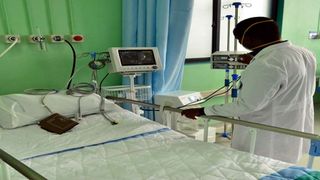
A doctor checks the equipment at the Intensive Care Unit at the Kenyatta University Teaching Referral and Research Hospital on August 5.
| File | Nation Media GroupNews
Premium
Rising Covid deaths expose need for ICU facilities in counties
What you need to know:
- The last week has seen ICU patent numbers range between 50 and 60, with more than 75 others needing life support.
- As of yesterday, more than 143 patients were critically ill, with 57 in ICU and 86 on oxygen support.
Kenya is staring at a crisis in the management of critical Covid-19 cases as the number of patients requiring intensive care unit admission rises by the day.
The last week has seen ICU patent numbers range between 50 and 60, with more than 75 others needing life support.
As of yesterday, more than 143 patients were critically ill, with 57 in ICU and 86 on oxygen support.
While there are 492 ICU beds in private and public hospitals across the country, many are being used by patients suffering from other diseases such as cancer, diabetes and high blood pressure.
Still, some counties do not have a single functional ICU because they lack critical elements — including health specialists, ventilators and oxygen supply.
A recent assessment by the Council of Governors (CoG) revealed that 11 counties have fewer than five beds in their ICUs, while others have mere rooms without the capacity to handle critical patients.
“The increased number of infections has strained the health system in the counties,” CoG chairman Wycliffe Oparanya said early this month as the pandemic resurged.
More worrying
“Currently, a number of counties are running on full capacity in the isolation wards, ICUs and HDUs meaning, therefore, that county governments can no longer admit new patients. It is actually an acute crisis and many patients are losing the battle en route to Nairobi to seek treatment.”
But what is more worrying is the recent directive by the Health ministry that each county should manage its own Covid-19 patients, and that there will be no inter-county referrals.
That leaves residents of ill-prepared counties such as Tana River and Lamu exposed to deaths as they are yet to put in place functional ICUs with capacities to handle many cases.
On Monday, Homa Bay County communication director Juma Kaluoch succumbed to Covid-19 after developing breathing problems.
It has since emerged that there was no ICU specialist to attend to him. The Nation has also learnt that the county’s ICU does not have a specialist doctor, nurse, and anaesthetist besides lacking drugs. And yet this is where Mr Kaluoch was admitted.
“He was the first patient to be attended to in that ICU. Without an ICU specialist, a nurse, an anaesthetist and drugs who attended to him? The room is basically as good as a store,” said Dr Kevin Osuri, Nyanza chairman of the Kenya Medical Practitioners and Dentists Union. Homa Bay often refers its patients to Kisumu and Kisii counties.
Empty ICU
An Isiolo-based nurse also succumbed to the virus last week while being transferred to Nairobi for treatment, with the medical fraternity claiming that Governor Mohammed Kuti launched “an empty ICU”.
“Governors have told us that they have the capacity, but healthcare workers are dying or are getting infected. This is an indictment on the Council of Governors; why are governors lying to us?” National Nurses Association of Kenya president Alfred Obengo posed.
Rising numbers
Kenya Medical Association (KMA) President Andrew Were said hospitals are witnessing rising numbers of patients requiring ICU services.
“An ICU bed requires staff. Some counties do not have the capacity to hire the required employees, let alone getting the beds. Many health workers are now at risk of contracting the virus,” the KMA boss said.
Dr Benjamin Wachira, Assistant Professor of Emergency Medicine at the Aga Khan University, Nairobi, and the current president of the African Federation for Emergency Medicine, said the demand for oxygen is likely to rise “10 times” over what other conditions currently consume.
“Oxygen is one of the essential commodities in the management of Covid-19 patients specifically for severe cases requiring breathing support. However, availability remains low in public health facilities (16 per cent), and where there it is available, the supply is not optimal and lacks the necessary distribution and delivery infrastructure,” he said.
Oxygen supply
“There is, therefore, an urgent need to address the oxygen supply gaps that have been identified,” he said.
A recent survey on emergency care centres across the country revealed that nine out of every 10 facilities do not have piped oxygen in their emergency departments, and delivered oxygen directly from the tanks to the patient.
This means a good number of facilities are rationing oxygen while deciding on who gets it.
“There is a need for hospitals to install an oxygen gas manifold in the emergency departments at the county referral hospitals,” said Dr Wachira.






